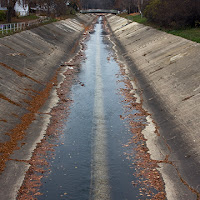Concrete River:
Memorial and Promise on the Kinnickinnic River
Photography by Eddee Daniel
Collaborative shrine and installation with Melanie Ariens
Alfons Gallery
1501 S. Layton Blvd., Milwaukee, WI
Opening reception: May 22, 1 - 3 pm.
Artist's remarks: 2 pm.
I hope you'll join me and Melanie for this event. This will not be an ordinary photo exhibit. We plan an installation that will make the gallery feel like the concrete channel.
Exhibit runs through July 31
Gallery hours:
Wed, Thu, Fri, Sun 12 - 3 pm
and by appointment.
For more information: Alfons Gallery website.
Artist's Statement:
Nothing kills a river
like concrete. How we treat rivers is suggestive of how we relate to the
natural world in general.
Historically, rivers have
been central to the growth of human civilization. This was as true at the
founding of Milwaukee as it was in the Fertile Crescent between the Tigris and
Euphrates. Somehow, though, in the late twentieth century, our modern society
lost sight of this vital truth. Milwaukee’s three rivers suffered many abuses,
including habitat loss, pollution and dams.
But there’s nothing like
pouring concrete into it, essentially transforming it into a drainage ditch, to
signal the destruction of a river. Sections of other rivers and creeks in the
Milwaukee River watershed were subject to this debasement, but the Kinnickinnic
River suffered the most.
In the 1960s the KK, as
it is still affectionately known, was straightened and lined with concrete in
order to mitigate flooding problems in the surrounding neighborhood. Although at
the time this dramatic action did provide some relief from the risk of
flooding, it also compromised the river in significant ways. The concrete
channel destroyed aquatic and riparian habitats, degraded water quality, and increased
the risk of drowning during high water flows. Ironically, today even the
original intent of the channelization has become outdated and ineffective for
flood control.
Fortunately, for the
river and for the community, attitudes have once again shifted. Caring for and
revitalizing rivers has captured the public imagination. On the KK the current
solution is a project to remove the concrete channel and restore the river to a
more natural condition. When I was invited by the Milwaukee Metropolitan
Sewerage District to document the project area I jumped at the opportunity.
It’s exactly the kind of subject to which I am drawn.
The KK River Project,
officially known as the Kinnickinnic River Corridor Neighborhood Plan, is a
joint endeavor by the MMSD and the Sixteenth Street Community Health Center. The
project area is located between 6th Street and 27th
Street. (An earlier phase of the project, completed in 2012, removed the
concrete channel downstream from 6th St.) The 50-ft. wide concrete
channel is to be removed and a 200 ft.-wide rock-lined river channel created.
This has necessitated the acquisition and deconstruction of 83 homes in order
to accommodate the wider river. Although most of those houses had already been
removed, I witnessed and documented the deconstruction of several of the few
remaining.
Because the project is in
its early phases, most of the images in this exhibit depict the river’s current
state as a concrete channel. Furthermore, the installation itself is intended
to reinforce the claustrophobic and treacherous conditions that exist. In order
to represent the more hopeful future of the KK, I have invited environmental
artist Melanie Ariens to collaborate with me on a water shrine to signify the
restored vitality that is envisioned in the KK River Project.















